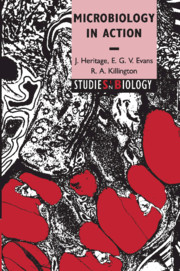Book contents
- Frontmatter
- Contents
- Preface
- 1 The microbiology of soil and of nutrient cycling
- 2 Plant–microbe interactions
- 3 The microbiology of drinking water
- 4 Microbial products
- 5 Food microbiology
- 6 The human commensal flora
- 7 Microbial infections
- 8 Chemotherapy and antibiotic resistance
- Further reading
- Glossary
- Index
7 - Microbial infections
Published online by Cambridge University Press: 05 June 2012
- Frontmatter
- Contents
- Preface
- 1 The microbiology of soil and of nutrient cycling
- 2 Plant–microbe interactions
- 3 The microbiology of drinking water
- 4 Microbial products
- 5 Food microbiology
- 6 The human commensal flora
- 7 Microbial infections
- 8 Chemotherapy and antibiotic resistance
- Further reading
- Glossary
- Index
Summary
How do microbes cause disease and how do we defend ourselves from infection
The vast majority of microbes that humans encounter on a daily basis do no harm. Indeed, the microbes that constitute our commensal flora are, on balance, beneficial under most circumstances. Only a minority of microbes can interact with humans to cause disease. These are known as pathogens from the Greek word pathos, meaning ‘suffering’. Some pathogens cause mild illnesses: others are responsible for life-threatening infections. Some infections are chronic, developing slowly over many months or years: others may be rapidly fatal. Virulence is the term used to describe the degree to which an organism can cause disease. This term is derived from the Latin word virus, meaning a poison. Some authors do use the terms ‘pathogenicity’ and ‘virulence’ interchangeably. Other authors prefer to reserve the term ‘virulence’ for a quantitative description of the degree to which a microbe can damage its host.
Infections spread from a source known as the reservoir of infection. These may be human beings, as with Salmonella typhi, animals, as with Salmonella typhimurium, or the environment. Soil is the reservoir of infection for tetanus, caused by Clostridium tetani, and water for Legionnaire's disease, caused by Legionella pneumophila. The source of infection is the individual or location from which an infection is acquired.
- Type
- Chapter
- Information
- Microbiology in Action , pp. 130 - 248Publisher: Cambridge University PressPrint publication year: 1999



